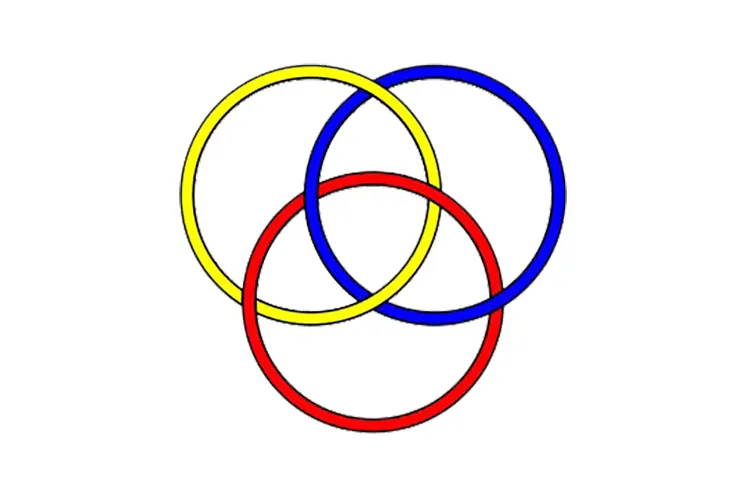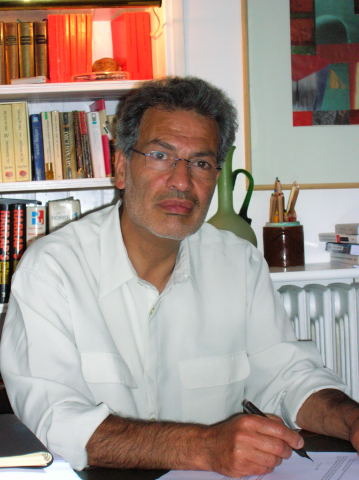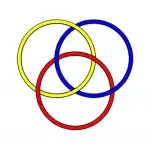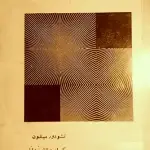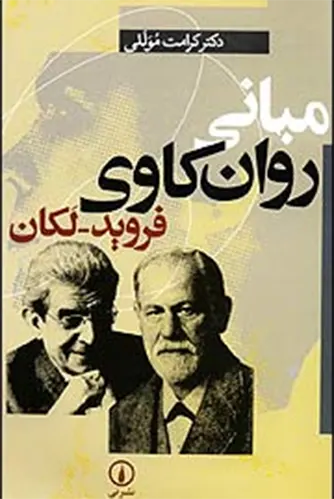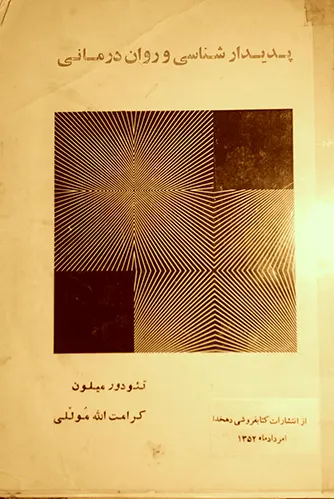PSYCHOANALYSIS AND TOPOLOGY
The theory of the knot (Jean-Michel Vappereau)
Topology is a branch of pure mathematics, deals with the fundamental properties of abstract spaces. Whereas classical geometry is concerned with measurable quantities, such as angle, distance, area, and so forth, topology is concerned with notations of continuity and relative position. Point-set topology regards geometrical figures as collections of points, with the entire collection often considered a space. Combinatorial or algebraic topology treats geometrical figures as aggregates of smaller building blocks.
BASIC CONCEPTS
In general, topologists study properties of spaces that remain unchanged, no matter how the spaces are bent, stretched, shrunk, or twisted. Such transformations of ideally elastic objects are subject only to the condition that nearby points in one space correspond to nearby points in transformed version of that space. Because allowed deformation can be carried out by manipulating a rubber sheet, topology is sometimes known as rubber-sheet geometry. In contrast, cutting, then gluing together parts of a space is bound to fuse two or more points and to separate points once close together. The basic ideas of topology surfaced in the mid-19th century as offshoots of algebra and ANALYTIC GEOMETRY. Now the field is a major mathematical pursuit, with applications ranging from cosmology and particle physics to the geometrical structure of proteins and other molecules of biological interest.
In essence, the topology of a space provides a way of telling which points are very close to one another and which are not. For instance, it supplies a way of determining whether a curve drawn on a space is continuous (unbroken) or not. However, it does not distinguish between a smooth and crinkly curve or say anything about the curve’s length. Topology does not deal with smoothness or size. Hence, a cube’s surface has the same topology as a sphere’s surface, even though one has sharp corners and the other smooth. Such topologically identical figures are termed homeomorphic. On the other hand, the surface of a sphere has a difficult topology from the surface of a torus (doughnut-shaped space).
A primary aim of topology is to find a serviceable set of rules or procedures for recognizing spaces in all dimensions. In such a classification scheme, two spaces would belong to the same topological class if they had the same basic, overall structure although they might differ drastically in their details.
The simplest topological spaces are known as Euclidean spaces. In general, the term DIMENSION signifies an independent parameter, or coordinate. A space has n dimensions if each of its points is completely determined by n independent numbers. An infinitely long line is a one-dimension Euclidean space. The plane is a two-dimensional Euclidean space. The space of ordinary experience is usually considered a three-dimensional Euclidean space.
MANIFOLDS
The term manifold covers more complicated types than Euclidean spaces. Manifolds locally appear flat, or Euclidean, but on a larger scale may bend and twist into exotic and intricate forms. Any surface, however curved and complicated, so long as it does not intersect itself, can be thought of as consisting of small, two-dimensional, Euclidean patches glued together. Special manifold characteristics, often expressed as numbers or algebraic expressions, help distinguish manifolds. Such expressions, known as topological invariants, provide a convenient way of categorizing manifolds. Dimension, the number of coordinates required to specify a point in a given space, is one example of a topological invariant. Manifolds may also be either bounded or unbounded. A circle is an example of a bounded, one-dimensional manifold, but a line stretching off indefinitely in both directions is unbounded. The same distinction applies to spaces of any dimension. Certain types of two-manifolds, termed compact surfaces, can be classified in terms of an invariant called the Euler number. For a compact surface divided into triangles, the surface’s Euler number equals the number of triangles minus the number of edges plus the number of vertices (a vertex is the point of a triangle farthest from its base). No matter how the surface is divided up into triangles–so long as no triangle’s vertex rests on another triangle’s edge–each different type of compact surface has a particular Euler number. The sphere has Euler number 2; the torus has Euler number 0; the surface of a two-handled soup tureen has a Euler number of -2. Each even integer less than or equal to 2 is the Euler number for exactly one type of closed surface.
The same idea can be expressed in terms of spheres to which are attached a certain number of handles. The surface of a sphere or a lump of clay fall into one group, whereas the surface of a doughnut or a coffee mug fall into another. Because both forms have one hole, one can imagine smoothly deforming a doughnut-shaped piece of clay to produce a mug with a single handle. On the other hand, there is no way, short of cutting, to turn a spherical balloon into an inner tube.
Topologists, using suitable invariations, can examine in detail what manifolds look like and how one can be transformed into another. Much manifold study concerns the search for more finely tuned invariants that make subtler distinctions. Because manifolds in higher dimensions are impossible to visualize, these invariants often stand in for the manifolds.
MANIFOLD CLASSIFICATION
Mathematicians have developed workable schemes for studying manifolds in every dimension except three and four. Dimension three remains a puzzle because proposed classification schemes cover only a portion of all conceivable three-manifolds. Recent attempts to demystify four-dimensional spaces reveal them to have special characteristics quite unlike those of any dimension, higher or lower. The Poincare conjecture, named for the French mathematician Henri POINCARE, ranks as one of the most baffling and challenging unsolved problems in algebraic topology. The central idea of homotopy theory (the theory of the relationship between topologically identical spaces) is to reduce topological questions to abstract algebra by associating with topological spaces various algebraic invariants. Poincare’s contribution was the invention of an abstract concept called the fundamental group for distinguishing different categories of two-dimensional surfaces. Poincare was able to show that any two-dimensional surface having the same fundamental group as the two-dimensional surface of a sphere is topologically equivalent to such a sphere. He then conjectured that the same relationship holds for three-dimensional manifolds, and other mathematicians extended the idea to higher dimensions. Ironically, mathematicians have provided the equivalent of Poincare’s conjecture for all dimensions except three. The central problem in proving the conjecture in three dimensions is that, unlike the two-manifolds cases, topologists have no complete classification scheme for three-manifolds. There exists no list of all possible manifolds that can be checked one by one to make sure that all have different homotopy groups.
KNOT THEORY
Topology is also concerned with the ways in which one manifold may be embedded within another, such as the ways a knotted circle may be embedded in three-dimensional space. A mathematical knot is the abstract result of first looping and interlacing a piece of string, then joining its ends together. Because any such knot is always topologically equivalent to a circle, the central questions in knot theory concern how that curve is embedded in three-dimensional space.
Knot theorists are particularly interested in identifying when curves are truly knotted, in finding ways of distinguishing different knots, and, more generally, in classifying all possible knots. Although a competent scout or sailor can readily identify and distinguish between a reef knot and a granny knot, mathematicians have a tougher task because they must deal with all conceivable knots. In many cases, two knots may look the same when, in fact, they are different. Alternatively, a knot may be so contorted that its true identity is masked.
To make knot classification easier, investigators examine the two-dimensional shadows cast by the three-dimensional knots. Even the most tangled configuration can be pictured as a continuous loop whose shadow winds across a flat surface, sometimes crossing over, and sometimes crossing under itself. One convenient measure of a knot’s complexity is the minimum number of crossings that show up after looking at all possible shadows of a particular knot. A loop without any twists of crossings (in its simplest form, a circle) is called an unknot. The simplest possible knot is the overhand, or trefoil, knot, which is really just a circle that winds through itself. In its plainest form, this knot has three crossings. It also comes in two forms: left-handed and right-handed configurations, which are mirror images of each other. Knot theorists have identified 12,965 distinct knots with 13 or fewer crossings.
A more sophisticated approach to distinguishing knots is to use the arrangement of crossings in a knot diagram to produce an algebraic expression–a polynomial invariant–that serves as a label for the knot. Recent discoveries of a wide range of new invariants show promise because they seem to distinguish more different types of knots than previously known invariants.
Topology and the question of structure
(written by Robert Groome from Psychoanalysis Los Angeles California Extension)
Independently of the propositions on culture and nature that thematize the field of psychoanalysis, Lacan has constructed its discipline in a topology (Greek topos [place] + logos [discourse/reason/logic]) which has become a basis on which to achieve Freudian psychoanalysis in its theory and practice.
What is called the structuralism of Lacan is inseparable from a psychoanalysis where place — topos — is more primary than the contents that fill it. The crucial problem of contemporary psychoanalysis is neither the multiplication of its contents through applications to cultural or clinical fields, nor that of borrowing ideas from the sciences and philosophy to renovate its theory, but of establishing a practice that opens up a theory of the fundamental topoi of (auto)organization and (auto)destruction that Freud had left at the level of a mythology of the drives of Eros/Thanatos and the Oedipus complex. This is very well to set forth the proposition, that psychoanalysis depends, in theory and practice, on the elaboration of its structure in a topology.
Yet, with the marketing of bookcovers and paraphrase on lacanian topology so far advanced that one can no longer ignore it, we must raise the unavoidable question whether this commerce is compatible with a construction of psychoanalysis beyond an illustrative use. Without prohibiting anyone from the use of a fantasy, we should ask if there is not a more fundamental un-doing, un-reading, or indeed traversing of such fantasies in the production of an effective topological and psychoanalytic work. In this short web essay, we only begin to respond to such a question by bringing out a geneology of the problem of a topological structure in the tradition of Freud and Lacan. We will begin, therefore, by a ‘soft’ historical introduction to the problem and will only follow in the next chapters to determine our structural monstrations. No doubt, the current opinion on Lacanian topology — including those of many psychoanalysts and topologists — is that such a topology would be, at best, an illustrative metaphor, or at worst, an imposture. Here,then, a fitting name for our project is La Topologie Perdue de la Psychanalyse – The Lost Topology of Psychoanalysis -; a title which appears to be so simple and regular that it renders account of the vertigo of the savant and the ignorant alike.
Psychoanalytic Topology: Metaphor, Analogy, or just Structure ?
If as Jacques Derrida would have us believe, “stricto sensu, the notion of structure only refers to space, morphological or geometrical space […]” and “it is only by metaphor that this literality topographic can be displaced towards its aristotelian and topic signification (the theory of places in language and the manipulation of motifs or arguments)”, then Derrida’s conception of structure — and thus psychoanalysis — is, no doubt, decidedly different than that of Lacan who stated that his topology was “not metaphorical” and has as its goal “to articulate the space of the speaking being”.
If Sokal and Bricmont’s critique of Lacan: “Everything is based — at best — on analogies between topology and psychoanalysis that are unsupported by any argument” is founded, then it becomes difficult to explain Lacan’s response to a question posed by Harry Woolf in an American seminar:
Woolf: May I ask if this fundamental arithmetic and topology are not in themselves a myth or merely at best an analogy for an explanation of the life of the mind?
Lacan: Analogy to what? […] It is not an analogy. It is really in some part of reality, this sort of torus. This torus really exists and it is exactly the structure of the neurotic.
To attempt to either justify such a response or contradict it without marking the difficulty of situating the concept of structure in a theory itself, is to take for granted what requires explaining in the first instance: the relation of structure to topology.
If structure is presupposed given as a concept and defined in a mathematical theory, then topology is one structure among others: group structures, vector space structure, manifold structure, etc. — and the conjunction of topology and psychoanalysis is a metaphor. But if the definition of the concept of structure cannot be taken for granted in a mathematical text — but is always more or less assimilated or trivialized to the particular theory of the mathematician1 — then the term topology can only be taken as an adjective in the phrase topological structure if one considers that the question of structure has been regulated beforehand. Consequently, the question of whether the conjunction of topology and psychoanalysis is a metaphor or not, is secondary to the question of how to situate precisely the relation between topology, structure, and theory. Indeed, in following the great strides that have been achieved by the logicians and mathematicians in determining a concept of structure, nothing prohibits the psychoanalyst from proceeding to give him or herself the same litteral methods of transliteration between theories. For, in fact, this method of translilteration is comparable to both Champollion’s method of going between two languages in the deciphering of the rosetta stone and Freud’s method of going between two languages in the interpretation of a dream.
For instance, just as it is possible to introduce a structural interpretation of a site by posing a Functor F from the category (or theory) of mathematics to music:
Category: Mathematics ———–> Music
12 (relations/elements) 12 Tones
Cyclic Well-tempered
Group Scale
it is possible to introduce a structural interpretation by posing a Functor (or Signifier) from the theory
of mathematics to psychoanalysis:
Mathematics ————–> Psychoanalysis
Torus Torus
Fundamental Neurosis
Group (theory of the Drives)
No doubt, the arrow between the two theories requires a concept of structure that is not a simple isomorphism, but a more modern Functorial conception corresponding to what in analysis is called a Signifier. It remains to be shown in what way a functorial doctrine of structure would suffice to encompass a psychoanalytic gesture in its work with tori; or further still, whether the arrow itself carries with it the semantics of a topology (as an initial probe one could present this double category as the homology – or pasting together – of two triangles:see footnote 1/below).
In the end, it is neither a question of applying mathematics to psychoanalysis, nor of doing a psychoanalysis of mathematics. Just as it is not a question of whether someone must become a mathematician in order to do psychoanalysis, but rather one of asking what type of ignorance does a psychoanalyst participate in by avoiding the use of such a rigorous writing ? Or inversely, it is not a question of asking someone to become a psychoanalyst in order to do mathematics, but rather of asking what type of ignorance would a topologist participate in by avoiding an analysis of the space of the dream, illusion, and hallucination ?
Psychoanalytic Topology: The Nature of its Lack
We aim to situate how a notion of structure emerges in terms of a topology which has always been missing from mathematics, or at least has always posed an obstacle to its mathematization. In this regard, such a topology is not merely in default, but as the celebrated biologist Buffon remarked “absolutely missing” or as Husserl would claim, that “Whatever the development of an exact science, that is to say operating on ideal infrastructures, it can not resolve the authorized and original tasks of a pure description”. Without stopping here to argue for or against what is being presumed in such statements, it suffices to note that the notion of structure has always emerged, whether in physics, biology, Gestalt psychology, or phenomenology precisely at the point of formulating the desire for something like a topology or analysis situs which has been thought missing.
A Short Geneology
In all the domains — physics, biology, psychology, anthropology, linguistics, economy, philosophy, etc. — where a structure posseses an empirical or cultural value and is revealed as necessary to the explication of it’s experience, its theoretical function has always been to go beyond one of the most ancient obstacles (in the sense of Bachelard) posed to scientific rationality: that between mechanism and vitalism. Briefly, this opposition comes to the fore once the former is determined as an entity in which the whole is reducible to the sum of its parts (a machine), while the latter can be determined as an entity of which the whole is greater than the sum of its parts (an organ). It is by no means established that a mechanism and organism are incompatible. What is established is that their compatibility, or lack of it, is discovered when the totality of the organism contains a supplement, an ‘error of the vital’, that creates an obstacle in the representation of an organ in terms of a machine.
For example, in its origin and development psychology has been the province of philosophers of the soul/organism (a Gestalt Psychology in the sense of Kohler or Descriptive Psychology in the sense of Bretano)and the mind/machine (Atomistic Psychology based on the association of ideas in the sense of Locke and Helmholtz). Yet, neither explication has succeeded to unite a mechanistic or organistic explication of the human being in one single synthetic judgement.
What ought to be recognized, but is rarely, is that this obstacle of representing the human being, is found in a more significant way the moment the human being attempts to represent the act of representation itself. From a purely logical viewpoint, it is under the aegis of a paradox of representation (more properly spoken of here as ‘mimesis’) that the problem of structure should be interrogated. For instance, it would involve recognizing a conflict between a classical conception of the function of art as composition with a romantic conception of the work of art (the oeuvre) as symbolic construction (see Wofflin’s distinction between graphic and the painterly styles). For the attention to the aporia that exists between a mechanist attempt to explain art as a composition of its parts – a representation – is not the same as a holistic attempt to explain the work of art as a contruction of a whole, an oeuvre. The latter, requires a reference to as an ‘essence of Life’ – a style, plasticity, vital error, subjectivity, genius, spirituality, etc. – which is a stranger to the composition of its parts.
Finally, all those psychologies that have taken Life as their domain of analysis have ended up replacing an analysis of representation with that of expression and giving it a content — in a Psychology of the Mind, or Philosophy of the Personality — irreducible to an atomist psychology. Heidegger reformulates this holistic reading of Life as a question of Dasein. For as long as one opposes an objectal domain of man as mere machine and automaton to a subject of analysis which escapes such representations, then the place of the subject is reduced to a science of the whole: genres of being, intentionality, spirit, psyche, mind, etc. annotated in an anthropology or a science of the personality. For Heidegger, such common readings of the totality of beings, impedes posing the fundamental question of Dasein and the place of Being itself. Indeed, it is well known that it is this ontic-ontological difference that Heidegger aims to establish as the basis of not only aporias of representation, but of all philosophical discourse. In this way, his critique of psychology and phenomenology occurs in the name of existential structures and a Topology of Being defined as the “locality of all localities”. A ‘dwelling place’ or ‘locality’ which Heidegger was to underline was “lacking a place”, or rather constantly being assimilated to the places of beings and facticity.
Towards a Topology of Repression
Without going further here into the problem, it suffices here to restate it: Why, then, the constant lack of place in the formulation of problems of topology and structure?
It appears that Lacan’s return to Freud by way of topology — whether it occurs casually or in line with highly self-conscious, philosophical mutations —upsets the taken for granted assumptions with which the profession of psychoanalysis has been operating for some time now. As a result, the attribution of a reliable or even exemplary knowledgeable and ethical function to psychoanalysis becomes much more difficult. But this is a recurrent psychoanalytic quandary that has never been resolved. The latest version of the question, which still determines many analysts’ present-day convictions about the aims of psychoanalysis, goes back to the rise of neurophysiology as an independent discipline in the 19th century. The link between representation, knowledge, and truth is the burden of Freud’s failed attempt to explain the psyche in a purely mechanical and quantitative modelization. Or rather, the construction of such a neuronal model is lacking, because it fails to render account of qualitative elements: the observing ego and the occurrence of consciousness. It is because it is common to teach psychoanalysis as a form of psychology, at least in the anglo-saxon inspired countries, that such ‘qualitative elements’ are classified as psychological properties, and not more precisely as invariants of a topological theory. This echoes a generally admitted position among professors of the ‘psy’ and is the reason one can nowadays pass so easily from neurophysiology to its apparent prolongations in the field of psychology. Whether a reading of Freud’s Scientific Project (Entwurf) and Beyond the Pleasure Principle would confirm this passage between mechanism and organism certainly stands in need of careful examination, which we can only touch on in such an essay.
In its origins and development, Freud proposes a vitalist hypothesis of the finality of an organism in order to explain repression (verdrangung) and attention. Otherwise said, he supplements the psychic machine determined by an analysis partes extra partes with a reflex circuit — an inertial system voiding quantity according to a principle of pleasure/unpleasure — in the attempt to explain the functioning of the whole in terms of an organism. From this ideal principle of ‘least action’, Freud progressively recognizes a spatio-temporal deployment of an internal organizing force and gives it the name of the libido and the drive. But one of the central results of Freud is the discovery of a drive irremediably disjoint from the spatio-temporality of Life or the auto-conservation of the organism: the Death Drive. It is in this respect, in the recognition of a non-biological relation of the sexed individual, that Freud passes from a neurophysiology seeking to model adaptation as ‘least action’ and defense (movement from an exterior stimuli), to a neuropathology seeking to model nonadaptation as ‘excessive or missed acts’ and pathological defense ( repression or an impossible flight). At this point, Beyond the Pleasure Principle, Freud’s reading of in-forms and discontinuity become more important than a continuous hypothesis of an internal organizing force of Life.
Psychoanalytic theory raises here the unavoidable question whether neurophysiological and psychological themes of Life can be compatible with the topological structures that make up the reality of the entities from which these themes are derived: their Sexuality and Death. What is established is that the insufficiency of such themes has to remain an open question and that the manner in which the teaching of psychoanalysis, at least since the middle of the 20th century, has foreclosed the question is unsound, even if motivated by the best of intentions. What also ought to be established, but rarely is, is that the clinic of psychoanalysis ought to take place under the aegis of this question.
From a pedagogical point of view, this is not difficult to achieve. It involves a change by which psychoanalysis, instead of being taught only as a historical and a humanistic subject, should be taught as a topology prior to any psychology or hermeneutics. The resistance to such a Lacanian move in France has been predictable, but can today be used to show what is being avoided by culturalist and humanist programs. For by re-theorizing the qualitative element of Freud topologically — as we will see in terms of the petite a — Lacan removed an obstacle to its theory and practice that continues to haunt many contemporary analysts. Attention to the formal differentiation of the individual and its milieu – or we will indicate later one signifier, then another – is prior to any theory of contents which would try to understand the individual as adapting to its environment or as developing according to an innate program of heredity. Counter the dominant continuist interpretations of the human subject emerging in the 20th century – primarily focussed on the individual’s adaptation to the environment and an innate genetic formation – Freudian psychoanalysis began to recognize a discontinuous relation of the individual to the formation of its milieu: one that determines the very differentiation of the individual in a theory of narcissism. Lacanian psychoanalysis disengages this natural observation in the formation of a structural concept: the obstacle between a theory of the individual and the milieu (the group, society, culture, etc.), between the part and the whole, is resolved by a seemingly innocuous move founded on a definition of structure exemplified in Cantor’s set theory. Here, the whole is equal to its part (even numbers are equal to the natural numbers for instance) which is further complicated by a problem of the invariancy of dimension (the first dimension seemed, to Cantor, to be equal to the second). Psychoanalytically, these problems can be used to landmark the emergence of structure in the topological isolation of the individual: the milieu (whole) is equivalent to the individual (part) as an oddly interior exteriority, thus making the problem of the individuation and the relation to an object particularly delicate. In a parallel manner, the obstacle opposing a vitalist to a mechanist explication of the formation of the individual becomes obsolete the moment one begins to theorize the organism as a transfinite machine or ‘cyborg’ (see George Canguillem’s Machine and Organisme and John Conway’s Game of Life).
Later, Lacan would state that language itself is a biological organ (as Chomsky had), and as such it is in a discontinuous relation to its milieu that the problem of the signifier is first raised. Lacan states “The speaking subject has the privilege of revealing the mortifying sense of this organ, and by this his or her relation to sexuality. This is because the signifier as such has, in barring the subject in its first intention, made the sense of death enter into it (the letter kills but we learn this by the letter itself). This is why every pulsion is virtually a pulsion of death” [E.848].
This place of language is now the milieu proper to the subject: it is no longer a question of situating the milieu of the biological individual or explaining its paradoxical defenses, but of situating the place of the speaking being in a topology of the subject.
To conclude, the early elaboration of structure by the biologists is in accord with the observations of the psychoanalysis in recognizing that a topology sufficient to the formalization of Life has always been radically in default — not because science has not yet discovered its secret — but because it is repressing. One sees that the whole problem is to determine a purely structural reformulation of the vitalist’s ‘part maudite’ (in the sense of Bataille); or in an algebraic ‘petite a’ (in the sense of Lacan); or the alpha and beta functions (in the sense of Bion) permitting psychoanalysis to escape from a purely speculative biology and the philosophies of Life.
The Missing Clinic of Psychoanalysis and the Current Lack of Psychoanalytic Literature on the Subject
Lacan drew attention to structure in a clinical theory by showing how the reading of the relation between what is seen and what is heard is able to transform the methodology of psychoanalysis in a manner that would only be subversive to those who think of teaching of psychoanalysis as a substitute for teaching philosophy, psychology, theology, zen, or literature. Clinical psychoanalysis becomes a topology almost in spite of itself because it cannot fail to respond to the problem of structure which it has been more or less the implicit aim of analytic teaching to avoid.
Since Lacan, students, as they began to analyze a case were instructed not to consider anything that was not derived from the case at hand. They were asked not to make statements that they could not support by a specific construction: instead of merely trying to understand the place of Man discursively in terms of philosophy, Lacan asked himself and his students to construct a thing — graphs, surfaces, or knots — that would exhibit the properties of holding together or connectedness. They were asked, in other words, to begin by not taking for granted the materiality of language and its place in the presentations of their own practice, while not to remain at the level of representing others in the context of human history or experience. Much more humbly, they were to start out from the misunderstandings that such a practice was bound to produce in clinicians and practicioners perceptive enough to notice them and courageous enough not to hide their ignorance behind the screen of received ideas that often passes in psychoanalytic instruction for humanistic research.
These very simple guidelines have had far reaching consequences in the training analysis. Yet, some never saw the point of focusing their attention on the matters at hand, and of presenting a structure as a way to construct experience, rather than commenting on experience itself. Indeed, the norm of the current literature in Lacanian psychoanalysis and its clinic was created by those who never found the time for such lessons. For what they see as the great power of Lacanian theory to critique and generalize just about anything — from politics to science — is in fact, nothing but a loss of precision and the foreclosure of any possible discourse on structure and the clinic. Others, no doubt, took the time, so much so that psychoanalysis, at least in France, would never be the same. Yet, a didactic in topology did not make their writing in psychoanalysis any easier for they no longer felt free to ‘free associate’ and fantasize without at least having a manner to construct the results of their practice. Today, in spite of the facticious paraphrases of Lacan, a book on clinical Lacanian analysis has yet to be written — as sound practicianers are slow writers, and in the present state of psychoanalysis, this can only be a sign of progress.
NOTES: 1 For instance, the notion of structure as modelled by sets in the early theory of Bourbaki is insufficient as it still pressuposes an ontology without ever clarifying the functional status of its object. Yet the latter Bourbaki rectifies this misreading, beginning with the use of echelons (or species) in its last chapters with Charles Ehresmann, then with the theory of faisceaux and esquisses, a concept of structure is de-ontologized from sets resulting in the birth of the notion of a category. In the United States this revolution of method began with Sanders Maclane, Eilenberg, and Lawvere. Needless to say, this algebraization of topology, whether in the notion of an esquisse or in the modern topos theory still carries with it the semantics of its algebraization to the extent the concept of structure remains a purely functional concept and is bound (at least in topos theory) to intuitionist logic. It remains to be shown if there is, then, an opening here in what has been called the ‘old’ polish school which proceeds in the opposite way: in the topologization of algebra (see Tarski’s: Topological Algebra and forthcoming article).

